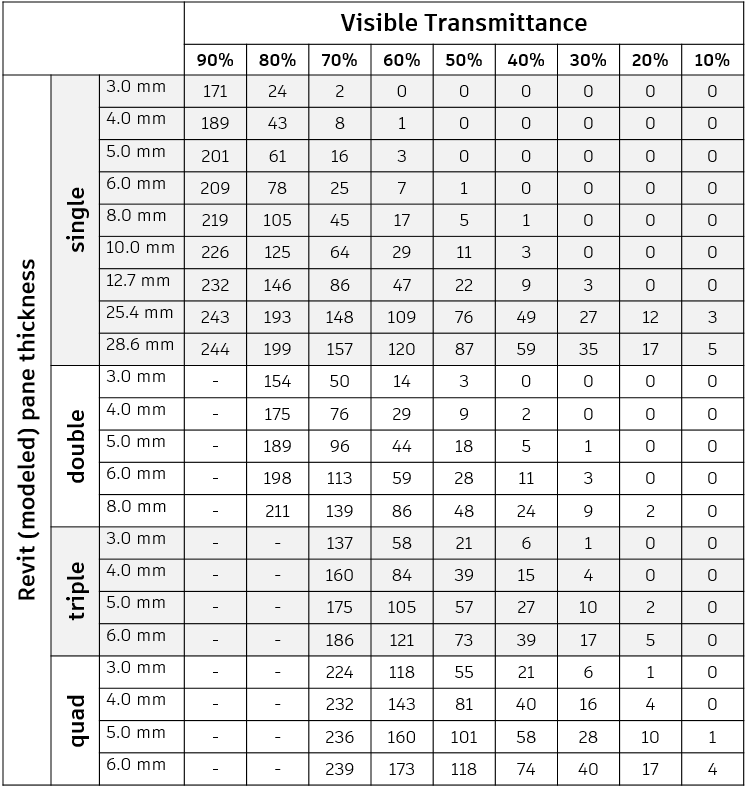Transparent Materials
Visible transmittance (Tvis) for transparent materials is an important consideration for lighting analysis. It will dictate how much light is able of entering the building through glazing. Visible transmittance is controlled by the RGB values in the Revit Material Browser. Follow the steps below to set visible transmittance for transparent surfaces.
The default visible transmittance settings for most glazing used in Revit window families are generally much higher than glazing values typically used in buildings today. Setting valid glazing Tvis is important for getting valid illuminance simulation results.
Select the glass pane that you want to edit. Select Edit Type from the Properties panel.

For Window elements, this can be done by editing the family. For Curtain Panels, this can be done by selecting the glazing element.
Glass panes that have a thickness of ½” to 1” (12.7mm to 25.4mm) will provide the most accuracy and flexibility in range of transparency.
To change the visible transmittance for the glass pane, edit the Material. This will open the Material Browser.

Note that the Analytical Properties of the glass will not affect lighting analysis results. These settings are for energy analysis only.
In the Material Browser, open the Appearance tab. The Appearance tab is the only tab that affects the results for illuminance analyses.
Make sure that the asset assigned to the material is an actual transparent material. If not, replace the asset using the Asset Browser and assign a transparent material, such as Glazing or Glass.


Once a transparent asset has been assigned to the material, under the Glazing section, change the Color to Custom. Then, enter the RGB values corresponding to pane thickness and desired Tvis.

The Reflectance setting is not used for illuminance renderings. The A360 Rendering engine uses a predefined reflectance of ~4%.
The Sheets of Glass is also not used for illuminance renderings. The A360 Rendering engine uses the actual modeled Revit geometry. For example, if a Revit window family includes two panes of glass, the illuminance rendering will consider the combined effect of both panels.
Diffuse glazing and the effect of light passing through frosted or fritted glass is not supported by Revit’s material and asset definitions.
To determine what RGB values to use to represent the desired Tvis for your glazing, use the table below, or download this worksheet. Defining the visible transmittance depends not only on the RGB values used, but also the thickness of the glass and how many panes are modeled in Revit.
It is recommended to always use RGB values that are equal to each other. This is for simplicity’s sake and should not affect analytical results since illuminance renderings are measuring the quantity of light, not the quality or color of that light.

To use this chart:
- Determine the modeled thickness of the glazing pane geometry in your Revit model and the number of panes modeled. For multiple panes, the thickness applies to each pane. These values are the rows.
- Determine the overall desired Tvis. This value is the column.
For example, for a double pane window where each pane is 3.0 mm thick, and a desired Tvis of 70%, the RGB values would be 50-50-50, and you would enter R50-G50-B50 into the Material Browser. Note that a “perfectly clear” piece of glass would have a Tvis of about 92%.
The actual Tvis derivation for a single pane of glass is calculated as:
Tvis = 0.9216 * 10^(thickness_in * log_10((color/255)^2))
Where thickness_in = thickness of the pane in inches color = value in the Revit dialog [0-255]
The table above calculates the inverse of this function. The equation is derived from the physics of light transport in glass. It combines the Beer-Lambert law of transmission and the Fresnel equations (which are used to calculate the leading constant:1-R). The renderer implements these physical equations because they automatically account for things like directional variation in reflectivity and transmissivity and greater absorption in thicker panes of glass. Further it ensures that glass is always handled in a physically correct and consistent manner.